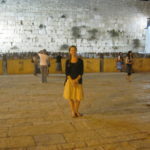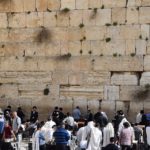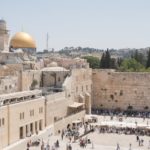Struggling with Israel: Conflicted Feelings in the Holy Land

For the last month, I’ve been struggling over what I wanted to share regarding my experiences in Israel. While impactful and moving moments made the travel experience rich at times, I sensed a persistent tension and distrust throughout the country. It was a low-lying and lingering fog–cold, eerie, barely visible, yet permeating nearly every location, event, and aspect of life.
In reflecting on my emotions and reactions to my time in this new yet historic country, I still find myself conflicted.
A trip here lets you check off lots of Life List dreams, but at the same time, this is the most uncomfortable, and sometimes unwelcome, I’ve ever felt in my travels. I’ll be processing this whole experience for a long time to come.
As with any of my articles, my perception is my own, and it may not reflect the opinions or viewpoints of others. I say that, not so much for you, the reader, but as a reminder to myself that I’m just a beginner when it comes to the complexities of Israel. I can only share my experience: what I saw, how I was treated, and how all that made me feel. But I recognize that there’s a richness and depth that I can one day better explore.
A trip here lets you check off lots of Life List dreams, but at the same time, this is the most uncomfortable, and sometimes unwelcome, I’ve ever felt in my travels.
Over the course of a few days–as my partner Rick and I made our way from Tel Aviv to the north, from the Galilee to the Golan, through the West Bank and into Jerusalem–we were inundated with multi-faceted layers of history, architecture, culture, politics, and religion. And we were struck by the physical beauty of the country, its coastal vistas, ancient architecture, Roman ruins, and lush countryside

My inner Catholic thrived in Israel. I couldn’t anticipate how strongly I would be affected, but I was hopeful for some kind of spiritual connection to the Holy Land, and I was bountifully rewarded. In the Galilee, as we sat by the waters upon which Jesus walked and where he gave the Sermon on the Mount, our guide Benny read to us from the Bible.
To hear those words that I have listened to virtually every Sunday of my life in the place where those stories happened over two thousand years ago was powerful. Somehow, there, in that moment, my religion was suddenly more tangible…more real.
In Jerusalem, at the Church of the Holy Sepulcher–which marks the place of the Crucifixion, I felt compelled to touch the slab of stone believed to be the location where Jesus’ dead body was prepared for the tomb. Being in that space with fellow believers, sharing that moment with my partner, appreciating how fortunate I was to be there at all, and recognizing that, according to my faith, I am saved because of what Jesus did for us all, I released my burdens in the form of countless, uncontrollable tears.
I felt humbly small, unworthy of such love.
I felt humbly small, unworthy of such love. And then I felt suddenly light, as though those burdens had truly been removed, freeing me to reflect the love Jesus bestowed upon me with all the world. A Christian, standing where Jesus died for our salvation, feels immensely grateful.

Visiting Jewish sites like the Western Wall–the last remnant of the wall that surrounded the Temple of Solomon and now the most sacred Jewish site–intrigued and moved me, too. It’s that celebration of one-ness that I love about travel.
Just as I had felt in Egypt when witnessing Muslims praying in mosques, seeing how Jews expressed their devotion and faith at this holy place convinced me once again that regardless of any differences people might have theologically, spiritually, politically, or personally, our humanity and our divinity binds us together.

That’s why a place like Yad Vashem is such an important place to visit (watch Rick Steves’ video about the Children’s Memorial at Yad Vashem). As the official Israeli memorial to Holocaust victims, this place invites visitors to not only remember those who suffered at the hands of the Nazis, their collaborators, their helpers, and their rescuers, but to humanize all of them.
Articles of clothing, children’s games, love letters, video testimonies made powerful testaments to lives lived, lives destroyed, and lives saved. The goal: for all of us to learn from the mistakes, atrocities, and sufferings of the past to prevent and eliminate them from our present and our future…a lesson with which our world continues to struggle.
Like it or not, their fates are intertwined, and breaking down barriers instead of creating them may be a better solution than the status quo.

However, for me, these beautiful and poignant moments were heavily shadowed by the pervasive tension I felt wherever we went. The borders between Israel and its neighbors like Lebanon and Syria are understandably well defended. But even within the country and within the walls of Old Jerusalem (a holy space where the three major monotheistic religions converge), distrust feels engrained in the society.
People take circuitous routes through the city to get from point A to point B just to avoid different religious neighborhoods. Young Israeli soldiers armed with automatic weapons stand guard at an entrance near the Cotton Market to decide who can go to the Temple of the Rock. Through this entrance, Muslims, yes.
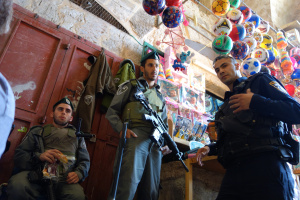
Jews and all others, no–presumably for their own protection and in accordance with Orthodox Jewish doctrine that forbids Jews to enter what once was the Holy of the Holies. Their colleagues do the same at multiple checkpoints for entrance into and exit out of the West Bank.
The prison-like walls (graffitied with anti-Israeli settlement comments) and fences that divide Israel and the Palestinian Territories seem to be more than their mere physical defenses–they’re powerful symbols of what keeps the Israelis and Palestinians on opposite sides of the same problem.
Like it or not, their fates are intertwined, and breaking down barriers instead of creating them may be a better solution than the status quo.
Like it or not, their fates are intertwined, and breaking down barriers instead of creating them may be a better solution than the status quo.

There were times when I felt unwelcome. In a strongly conservative, Orthodox neighborhood–where women are required to wear dark skirts or dresses, married women cover their hair with either cloth or a wig, and where men dress in virtually identical black suits, black hats, and beards –I felt like a scarlet-lettered harlot for wearing jeans and a ponytail in this stark, monochromatic part of town. I even got the stink eye from little seven-year-olds.
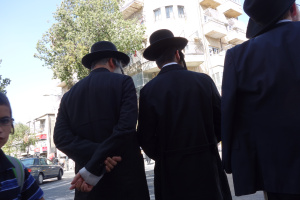
And at the airport, I spent over an hour with various security agents who escorted me from one checking station to the next to the next and to the next, meticulously examined my luggage and sorted through its contents four times, and repeatedly asked me questions about my past and future travels.
Female guards felt me up two separate times while checking for “suspicious items” on my person (I almost felt like I should pay the women for such personal services). I didn’t know if this was standard procedure or if I was just special, but a taste of this raised new sympathies in me for anyone who is deemed dubious by authorities.
When we asked Shani and her sister Adi about their hopes for the future of their country, both confidently replied that respect and understanding of the plight of Palestinians is growing in their generation.
For the peoples who call this land home, the complex and deep-seated issues from ages past are compounded by the grim, and sometimes dangerous, complications of today. Blame and fear motor endless cycles of revenge, self-defense, attack, and more defense. And the questions raised are as old as time: what belongs to whom, who was first, who started it, who is right, who’s to blame?
These spiraling questions make me think of a dog chasing its own tail or barking at its reflection in the mirror. Workable answers to the problems have eluded everyone, but I wonder whether these are even the right questions to ask. Do they bring anyone closer to a solution or do they just breed more animosity?

Perhaps the answers rest with future generations. One of our last experiences was joining our friend Uri and his beautiful family for an Israeli Independence Day barbecue in their home. Being welcomed so warmly and sharing in a bountiful meal with locals, Rick and I felt so blessed. Uri’s beautiful daughters–both in their 20s–openly shared stories about love, friends, work, travel, politics, and religion.
When we asked Shani and her sister Adi about their hopes for the future of their country, both confidently replied. They said that respect and understanding of the plight of Palestinians is growing in their generation.
The family is Jewish Israeli, but they have roots in Morocco, Libya, Turkey, and Russia. They incorporate secular and non-Jewish religious traditions from those countries into their everyday lives. The eldest daughter, Shani, was recently married and wove elements of her diverse heritage (and her husband’s) into the wedding celebrations.

When we asked Shani and her sister Adi about their hopes for the future of their country, both confidently replied. They said that respect and understanding of the plight of Palestinians is growing in their generation. They recognize that current political “solutions” aren’t working and that a sensible alternative is not found in the extremes, but somewhere in the middle.

Feeling well nourished from the abundant feast and appreciative of the time spent with this Israeli family on their country’s Independence Day, we all laughed as the father brought in yet another plate of grilled chicken for us. With happy smiles, we patted our overstuffed bellies. Uri understood our gratitude and contentment.
Looking to Rick and I, then to his daughters, he shared some fatherly wisdom–”Reaching towards each other with open palms is more productive than with closed fists.”
Uri smiled back and thanked us for coming into his home to get to know his family. Looking to Rick and I, then to his daughters, he shared some fatherly wisdom–”Reaching towards each other with open palms is more productive than with closed fists.”
For a decade and a half, Trish Feaster has traveled throughout Europe, the Philippines, Central and South America, and in the good old U.S. of A. During her nearly fifteen-year tenure as a high school Spanish teacher in California, Trish shared her love of travel with her students by taking them on annual trips to Europe. These days, she’s expanding her “classroom” even more and working as a tour guide and guidebook researcher in Europe. You can follow her travel adventures at www.thetravelphile.com, “like” her Facebook page at
www.facebook.com/thetravelphile and follow her on Twitter at @thetravelphile.
Struggling with Israel: Conflicted Feelings in the Holy Land Related Reading
Have you traveled to the holy land? What were your impressions? Email us at editor@pinkpangea.com for information about sharing your experience and advice with the Pink Pangea community. We can’t wait to hear from you.
Struggling with Israel: Conflicted Feelings in the Holy Land photo credits: Trish Feaster and unsplash (top).



